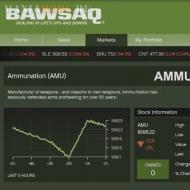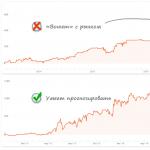
Actively passive accounts how to determine. Proper definition of the balance on active-passive accounts at the level of analytical accounting. Types of passive accounts
"Debit" and "Credit" - words of Latin origin. Translated into Russian, the word "debit" means "he must", hence the debtor - the debtor or borrower. The word "loan" means "he believes trusts", hence the lender - the lender, i.e. Face, giving money or other values \u200b\u200bto another person.
Currently, the words "debit" and "loan" turned into simple terms, denoting parties to the account (debit - the left side of the account, the loan is the right side).
"Saldo" - the word of Italian origin means "calculation", it is used to designate the difference between the debit and credit.
Recording on accounts begin with an indication of the initial balance (balance). Then the accounts reflect all operations that cause changes to the initial residues. Amounts that increase the initial residue are recorded on the side of the residue, and the amounts that reduce the initial residue are the opposite side. If you fold the sums of all operations recorded on the side of the account, account turns are obtained, the total amount recorded by the debit of the account is called debit turn, and on credit credit. When counting revolutions, the initial residue is not taken into account. The final residue is recorded on the same side where the initial residue.
On theactive Accounting accounts are recorded by the movement of the company's assets, i.e. availability, receipt and disposal household agents. Active account scheme
|
Balance initial - the remainder (availability) of household funds at the beginning of the reporting period | |
|
increase economic funds during the reporting period |
reductioneconomic funds during the reporting period |
|
Self finite - the balance of household agents at the end of the reporting period |
On thepassive Accounting accounts are taken into account the sources of education of economic funds. By analogy with active accounts, it can be said that the passive accounts are taken into account the movement of the liabilities of the enterprise. The main liabilities or sources of the formation of economic funds include all types of capital, profits and the obligations of the enterprise.
Passive account scheme
|
Balance initial - the rest of the sources of education of economic funds at the beginning of the reporting period |
|
|
The debit turnover is the amount of economic operations causing reduction |
Credit turnover - the amount of economic operations causing increase sources of education of economic funds during the reporting period |
|
Saldo Final - the rest of the sources of education of economic funds at the end of the reporting period |
Active accounts have the following features:
they reflect the presence and movement of business and property of the enterprise;
balance initial always debit and shows the availability of funds at the beginning of the reporting period;
the debit revolutions reflect the receipt of funds;
loan turnover shows the disposal of funds;
balance finite always debit and shows the balance of funds at the end of the reporting period.
Balance The final is calculated by the formula:
FROM to \u003d S. n. + O. d. - ABOUT to
Passive accounts also have features:
in passive accounts, accounting for the sources of education of economic funds of the enterprise, i.e. capital and obligations (debt);
balance The initial is always a loan and shows the amount of capital or the availability of the enterprise's obligations at the beginning of the reporting period;
the debit turns show a decrease in capital or obligations;
rolls on the loan show an increase in capital or obligations;
the balance finite is always a loan and shows the amount of capital or the obligations of the enterprise at the end of the reporting period.
The balance is calculated by the following formula:
FROM to \u003d S. n. + O. to - ABOUT d.
There are also active passive accounts that are mainly intended to account for obligations (calculations with different legal entities and individuals), as well as to identify financial results.
On active-passive accounting accounts, settlements are recorded with various organizations or individuals, i.e., accounting receivables and accounts payable.
If the company uses attracted or borrowed means, then it has accounts debt in front of other organizations or individuals who are creditors This enterprise.
If there must be other organizations or individuals, then these debtors call debitors, and they debt enterprise - receivables.
Debitors must be an enterprise, and the creditors must be the enterprise itself. The word "debit" is formed from Latin Debet, which means "should", and "Credit" - from the Latin word Credo, which means "believe."
Active Passive Account Scheme
| Balance initial - availability accounts receivable At the beginning of the reporting period |
Balance Primary - the presence of payables at the beginning of the reporting period |
| The debit turnover: an increase in receivables; Reducing payables |
Credit turnover: an increase in payables; Reducing receivables |
| Saldo Final - the availability of enterprise receivables at the end of the reporting period (when to him, enterprise, should) |
Saldo Final - the availability of payables in the enterprise at the end of the reporting period (when it, the enterprise, must) |
The main actively passive accounts include:
71 - "Calculations with accountable persons";
75 - "Calculations with founders";
76 - "Calculations with different debtors and creditors";
99 - "Profit and losses".
At the account 71, calculations are underway with accountable persons. Accountable persons are employees of an enterprise that from the cashier is issued money for travel expenses or economic needs, i.e. to buy goods on small sums. After the employee spent the money received, he must report, i.e. Provide accounts for the purchase of goods, rail or air tickets, hotel bills, etc. All this is approved in the Advance Report, which gives accountable person. These costs are usually written off as production costs.
Consider at the examples as accounting on active passive accounts.
Example 2.5. Keeping accounting for settlements with accountable persons.
At the beginning of the month, the accountable person of Petrov A. S. has an indebtedness to the company 500 p. (receivables). During the month, the following economic operations are reflected related to accountable persons:
The task. Embed an active-passive account 71 "Calculations with accountable persons", calculate turns and balance.
In order to determine the balance of the final on an active passive account, you need to calculate all amounts of debit, including the initial balance, in the same way the final amount of the loan should be calculated. The rally finite on an active passive account will be where the amount is more, and will be equal to the difference of amounts on the debit and loan.
Account 71 "Settlements with accountable persons"
Regarding the account 99, which was previously considered as passive, I should say the following: All enterprises work, having a major goal - receiving profits, but if for any reason they carry losses, then in this case, the score 99 becomes active and passive. Consider on the example, how to account on the account 99 "Profit and losses".
Example 2.6. Keeping accounting for profit and loss. At the beginning of the month, the enterprise has a loss of 4000 p. During the month, the following economic operations reflect:
The task. Embed an active-passive account 99 "Profit and losses", calculate turns and balance.
Account 99 "Profits and losses"
Accounting accounts allow us to take into account all operations, daily carried out in the organization, and provide maintenance accounting. What an account is, you can read in, it is written very simple and understandable.
All existing accounts can be divided into active, passive and actively passive. What do they differ and what is taken into account? We will deal with these issues below. At the bottom of the article, a table is given in which you can see what an account relates to active, as passive, and what to actively passive.
The view of the account depends on the fact that it should take into account assets, liabilities or other. You can read about assets and liabilities, everything is also written.
Active
The name speaks for itself. These accounts are intended to account for the assets of the enterprise, while the increase in the asset is reflected in the debit, the decrease in the asset - on the loan. Active accounts can be recognized by the presence of debit balance. Also, the balance can be zero when the debit turnover is equal to the loan turnover. Active accounting accounts cannot have a loan balance.
Examples of active accounts:
- 01 "Fixed assets"
- 10 "Materials";
- 20 "Basic Production"
- 50 "Cassa".
A complete list can be found in the table below.
Passive
 Designed to take into account the liabilities of the enterprise, the debit reflects a decrease in liabilities, on the loan - its increase. A distinctive feature of passive accounts is that its balance is always a loan or equal to zero, the balance of the passive account cannot be debit.
Designed to take into account the liabilities of the enterprise, the debit reflects a decrease in liabilities, on the loan - its increase. A distinctive feature of passive accounts is that its balance is always a loan or equal to zero, the balance of the passive account cannot be debit.
Examples of passive accounts:
- 02 "Depreciation of fixed assets";
- 66 "Calculations for short-term loans and loans ";
- 70 "Calculations with wage personnel";
- 80 " Authorized capital" other.
A complete list of passive accounts can be found in the table below.
Active passive
Interesting invoices called active passive. They got such a name for the fact that they can work as both active and passive accounts. For them, the rules set for active and passive accounts are performed, that is, assets and liabilities, and liabilities can also be taken into account on active passive accounts, and his liabilities, both debit and credit.
How can this be? We'll figure it out on a simple example.
Account 62 "Calculations with buyers and customers" is an active passive account.
As active he acts in the following situation: the organization supplies the goods per 100 rubles to the buyer, while the buyer receivables are formed before the organization. Accounts receivable is an asset, its increase is reflected in the debit of account 62. When the buyer pays the goods, receivables (asset) decreases, this decrease is reflected in the CC loan. 62. In this situation, the sch. 62 plays the role of active.
As a passive account 62 may appear in the following situation: the buyer lists an advance payment in the amount of 100 rubles, paying in advance the cost of goods before delivery. At the same time, the Credit Debt is formed before the buyer. Accounts payable is a liability, an increase in liability is reflected on the credit of the account (on the loan. 62). After the organization charges the goods, payables will close (decrease), this is a decrease in liability and will affect the debit of sch.62. In this case, the account 62 behaves as passive.
That is, 62 account cannot be unequivocally attributed to active or passive, so it stands out in a separate group of active passive. There are quite such accounts.
Examples of active passive accounts:
- 60 "Calculations with suppliers and contractors";
- 68 "Calculations for taxes and fees";
- 69 "Calculations for social Insurance and provision;
- 70 "Calculations with wage personnel", etc.
A complete list of actively passive accounts can be found in the table below.


The structure of the active passive account is shown in Table 1
Table 1 Active Passive Account Scheme
Based on Table 1, it can be concluded that an active-passive account includes two bills: active and passive. In the practice of accounting, active-passive accounts are usually divided.
The final balance of actively passive accounts is calculated as follows:
Calculated collapsed (debit or credit) balance for each analytical account.
The deployed balance of the synthetic account is calculated by separate summation of all debit and credit outgoing balance for each analytical account.
Allocate active passive accounts of two types:
actively passive bills with rolled balance;
active passive bills with deployed balance.
Active passive bills with rolled out balance are accounting accounts that may have either debit or credit balance. But only one of them.
For example. A classic example of an active passive account with a folded balance is an account<Прибыли и убытки>. During the reporting period, all losses are recorded at the debit of this account, and on the loan - profits from economic outdoor operations. At the end of the reporting period, debit and credit turns are calculated. If the debit turn (amount of losses) is more loan turnover (profit amount), it means that the company works with a loss, which is reflected in the debit balance in the account<Прибыли и убытки>. If the credit turn is more debit turnover, the company received a profit in the reporting period, which is reflected by the loan balance in the account<Прибыли и убытки>. That is, at the reporting date<Прибыли и убытки> May have either debit or credit balance. But only one of them, as the enterprise for reporting period May receive either a loss or profit.
The final balance on such accounts is calculated by separate summation of all records on the debit and loan (including incoming balance) and subtracting a smaller amount from greater. The final balance is recorded on the side of the longer amount.
Active passive bills with a deployed balance are accounting accounts on which at the reporting date can be simultaneously recorded both debit and credit balance. Such accounts, as a rule, include accounting accounts.
For example, an enterprise<Мелькомбинат> It has accounts payable to Mosenergo in the amount of 50,000 rubles, and the receivables of Mosteploenergo - 2000 rubles. It's obvious that<Мелькомбинат> must take into account the calculations with these two counterparties apart, so in the development of the account<Расчеты с прочими дебиторами и кредиторами> Open two subaccounts -<Расчеты с Мосэнерго> and<Расчеты с Мостеплоэнерго>. By subaccount<Расчеты с Мосэнерго> Reflects payables<Мелькомбината> Before Mosenergo (credit balance) - 50,000 rubles, by subaccount<Расчеты с Мостеплоэнерго> Receivable Mosteplonergo receivables before<Мелькомбинатам> (debit balance) - 2000 rubles. The question is which balance should be reflected in a synthetic account.<Расчеты с прочими дебиторами и кредиторами>? Often say that the final loan balance should be reflected - 48,000 rubles (i.e. balance<сворачивают>). In this case<Мелькомбинат> I am misleading your users, because in the balance sheet it will be said:<Мы должны лишь 48000 рублей>. Actually<Мелькомбинат> Must 50,000 rubles, and it must be 2000 rubles. And if Mosteploenergo does not pay off its debt in 2000 rubles<Мелькомбинату>, this does not mean that<Мелькомбинат> Do not fully pay 50,000 Mosenergo rubles. Consequently, at the reporting date on a synthetic account<Расчеты с прочими дебиторами и кредиторами> Must be reflected<развернутое> Self - 2000 rubles debit balance and 50,000 rubles loan balance. The debit balance will be reflected in the balance of the balance as receivable debt in the amount of 2000 rubles, and the loan balance is like payables of 50,000 rubles.
On passive accounting accounts, the sources of education of economic funds are recorded. By analogy with active accounts, it can be said that the passive accounts are taken into account the movement of the liabilities of the enterprise. The main liabilities or sources of the formation of economic funds include all types of capital, profits and the obligations of the enterprise.You can give the following characteristic passive account:
In passive accounts, accounting for the sources of education of economic funds of the enterprise, i.e. capital and obligations (debt) of the enterprise;
Balance The initial is always a loan and shows the amount of capital or the availability of the enterprise's obligations at the beginning of the reporting period;
The debit turns show a decrease in capital or enterprise liabilities;
Rolls on the loan show an increase in capital or obligations of the enterprise;
The balance finite is always a loan and shows the amount of capital or the obligations of the enterprise at the end of the reporting period.
The balance is calculated by the following formula:
SK \u003d CH + OK - one
Passive account scheme
The main passive accounts include:
80 - "authorized capital";
82 - "Reserve capital";
83 - "Extension Capital";
99 - "Profits and losses";
66 - "Calculations on short-term loans and loans";
67 - "Calculations for long-term loans and loans ";
60 - "Calculations with suppliers and contractors";
68 - "Calculations for taxes and fees";
69 - "Social insurance and provisional settlements";
70 - "Calculations with personnel on labor payment." Consider how accounting is made on passive accounts, on the following example.
Example: keeping accounting for passive accounts.
At the beginning of the month, the company has a debt to the bank for a loan of 80,000 p.
During the month, the following economic operations are reflected related to the lending to the enterprise:
Task: To issue a passive account of 66 "Calculations on short-term loans", calculate turns and balance.
Account 66 "Calculations for short-term loans"
Active Self Accounts
On active-passive accounting accounts, settlements are recorded with various organizations or individuals, that is, the accounting of receivables and payables.If the company enjoys attracted or borrowed funds, then it has accounts payable to other organizations or individuals who are creditors of this enterprise.
If there must be other organizations or individuals to the enterprise, then these debtors are called debtors, and their debt enterprise is receivable.
Debitors must be an enterprise, and the creditors must be the enterprise itself. The word "debit" is formed from Latin Debet, which means "should", and "Credit" - from the Latin word Credo, which means "believe."
Scheme of active-passive account:
|
Balance initial - availability of receivables at the beginning of the reporting period |
Balance Primary - the presence of payables at the beginning of the reporting period |
|
The debit turnover: an increase in receivables; Reducing payables |
Credit turnover: an increase in payables; Reducing receivables |
|
Saldo Final - the availability of enterprise receivables at the end of the reporting period (when to him, enterprise, should) |
Saldo Final - the availability of payables in the enterprise at the end of the reporting period (when it, the enterprise, must) |
The main actively passive accounts include:
71 - "Calculations with accountable persons";
75 - "Calculations with founders";
76 - "Calculations with different debtors and creditors";
99 - "Profit and losses".
At the account 71, calculations are underway with accountable persons. Accounting persons are employees of the enterprise, which from the cashier is issued money for travel expenses or economic needs, i.e., to buy goods into small amounts. After the employee spent the money received, he must report, i.e. Provide accounts for the purchase of goods, rail or air tickets, hotel bills, etc. All this is approved in the advance report, which gives an accountable person. These costs are usually written off as production costs.
Consider at the examples as accounting on active passive accounts.
Example: keeping accounting for calculations with accountable persons.
At the beginning of the month, the accountable person of Petrov A. S. has an indebtedness to the company 500 p. (receivables).
During the month, the following economic operations are reflected related to accountable persons:
The task. Embed an active-passive account 71 "Calculations with accountable persons", calculate turns and balance.
In order to determine the balance of the final on an active passive account, you need to calculate all amounts of debit, including the initial balance, in the same way the final amount of the loan should be calculated. The rally finite on an active passive account will be where the amount is more, and will be equal to the difference of amounts on the debit and loan.
Account 71 "Settlements with accountable persons"
Regarding the account 99, which was previously considered as passive, I should say the following: All enterprises work, having a major goal - receiving profits, but if for any reason they carry losses, then in this case, the score 99 becomes active and passive. Consider on the example, how to account on the account 99 "Profit and losses".
Example: keeping profit and loss accounting. At the beginning of the month, the enterprise has a loss of 4000 p.
During the month, the following economic operations reflect:
|
1. Production profit from sales |
||||||||||
|
Analytical accounts that are used for the detailed characteristics of the observation object. They are opened in the development of each synthetic account. Structure of an active passive account:
Accounts on which the property of the organization, its obligations and economic processes are reflected in generalized, are called synthetic. For example, these are the accounts "fixed assets", "Calculations for labor pay", etc. Accounting carried out on synthetic accounts is called synthetic. It is carried out only in monetary terms. For prompt manual economic activities, as well as control over the safety of the overall data obtained by synthetic accountingnot enough. For example, except for data on total amount fixed assets, it is necessary to have information about each facility of fixed assets separately (building, equipment, machines, etc.); To have a complete picture of the calculations with personnel on wage, you need to know the details of the calculations with each employee separately (Petrov, Sidorov, etc.). Analytical accounts are used to obtain detailed, dissected, analytical data on accounting objects. Accounts on which detailed data are reflected in each individual type of property, the obligations of organizations and processes are called analytical. Accounting carried out on analytical accounts is also called analytical. Analytical accounts are opened in addition to synthetic for the purpose of their detail and receiving private indicators for each individual type of property, the source of property formation, economic operation. For example, analytical accounts "Gasoline" can be opened to the synthetic account "Materials", "Divine", etc. In this case, analytical accounts will show the movement of each material separately. Obviously, the following conditions will be performed. The amounts of debit and loan revolutions of analytical accounts will be equal to debit and credit turnover of the combining synthetic account. The amount of initial remnants of analytical accounts will be equal to the initial residue of the synthetic account uniting them. The same can be said about the ultimate balance. Characteristics of passive account1. Reflect the sources of formation of economic funds.2. Are in the balance liability. 3. The library initial is in the loan of these accounts, reflects the availability of sources at the beginning of the reporting period (STICH). The residue for a passive account is always credit and either more or equal to zero. 4. An increase in business sources is reflected on the loan of these accounts, is called a loan turnover (KO). 5. Reducing sources is reflected in the debit of these accounts, is called debit turn (up to). Example passive account Consider a passive account 70 "Calculations with staff for wage." We assume that the initial balance on the account was not (i.e. it is zero). Suppose that the following operations occurred: 1. Accrued salary to employees of an enterprise in the amount of 30,000 rubles. The account increases (since the enterprise has indebted to employees before the payment of the salary), an increase in the passive account occurs on the loan. Decision: Open an account and enter the initial balance, then we are broader the amount of operations: amounts, reducing the account, put in the debit of account (according to the passive account scheme), and the amounts of an increase in the account put on credit account (according to the characterization of a passive account). |
















